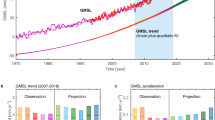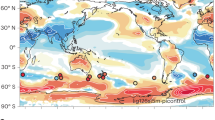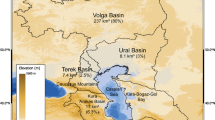Abstract
Human-induced climate change could cause global sea-level rise. Through the dynamic adjustment of the sea surface in response to a possible slowdown of the Atlantic meridional overturning circulation1,2, a warming climate could also affect regional sea levels, especially in the North Atlantic region3, leading to high vulnerability for low-lying Florida and western Europe4,5,6. Here we analyse climate projections from a set of state-of-the-art climate models for such regional changes, and find a rapid dynamical rise in sea level on the northeast coast of the United States during the twenty-first century. For New York City, the rise due to ocean circulation changes amounts to 15, 20 and 21 cm for scenarios with low, medium and high rates of emissions respectively, at a similar magnitude to expected global thermal expansion. Analysing one of the climate models in detail, we find that a dynamic, regional rise in sea level is induced by a weakening meridional overturning circulation in the Atlantic Ocean, and superimposed on the global mean sea-level rise. We conclude that together, future changes in sea level and ocean circulation will have a greater effect on the heavily populated northeastern United States than estimated previously7,8,9.
This is a preview of subscription content, access via your institution
Access options
Subscribe to this journal
Receive 12 print issues and online access
$259.00 per year
only $21.58 per issue
Buy this article
- Purchase on Springer Link
- Instant access to full article PDF
Prices may be subject to local taxes which are calculated during checkout




Similar content being viewed by others
References
Meehl, G. A. et al. in Climate Change 2007: The Physical Science Basis. Contribution of Working Group I to the Fourth Assessment Report of the Intergovernmental Panel on Climate Change (eds Solomon, S. et al.) 747–845 (Cambridge Univ. Press, 2007).
Gregory, J. M. et al. A model intercomparison of changes in the Atlantic thermohaline circulation in response to increasing atmospheric CO2 concentration. Geophys. Res. Lett. 32, L12703 (2005).
Levermann, A., Griesel, A., Hofmann, M., Montoya, M. & Rahmstorf, S. Dynamic sea level changes following changes in the thermohaline circulation. Clim. Dyn. 24, 347–354 (2005).
Douglas, B. C., Kearney, M. S. & Leatherman, S. R. (eds) Sea Level Rise: History and Consequences (Academic, 2001).
Stouffer, R. J. et al. Investigating the causes of the response of the thermohaline circulation to past and future climate changes. J. Clim. 19, 1365–1387 (2006).
Vellinga, M. & Wood, R. A. Impacts of thermohaline circulation shutdown in the twenty-first century. Clim. Change 54, 251–267 (2002).
Colle, B. A. et al. New York City’s vulnerability to coastal flooding. Bull. Am. Meteor. Soc. 89, 829–841 (2008).
Gornitz, V., Couch, S. & Hartig, E. K. Impacts of sea level rise in the New York City metropolitan area. Glob. Planet. Change 32, 61–88 (2001).
Jacob, K., Gornitz, V. & Rosenzweig, C. in Managing Coastal Vulnerability (eds McFadden, L., Nicholls, R. & Penning-Rowsell, E.) 139–156 (Elsevier, 2007).
Knutti, R. & Stocker, T. F. Influence of the thermohaline circulation on projected sea level rise. J. Clim. 13, 1997–2001 (2000).
Maximenko, N. A. & Niiler, P. P. in Recent Advances in Marine Science and Technology 2004 (ed. Saxena, N.) 55–59 (PACON International, 2005).
Levermann, A. & Born, A. Bistability of the Atlantic subpolar gyre in a coarse resolution climate model. Geophys. Res. Lett. 34, L24605 (2007).
Bryan, K. The steric component of sea level rise associated with enhanced greenhouse warming: A model study. Clim. Dyn. 12, 545–555 (1996).
Landerer, F. W., Jungclaus, J. H. & Marotzke, J. Regional dynamic and steric sea level change in response to the IPCC-A1B scenario. J. Phys. Oceanogr. 37, 296–312 (2007).
Stammer, D. & Huttemann, S. Response of regional sea level to atmospheric pressure loading in a climate change scenario. J. Clim. 21, 2093–2101 (2008).
Yin, J. & Stouffer, R. J. Comparison of the stability of the Atlantic thermohaline circulation in two coupled atmosphere-ocean general circulation models. J. Clim. 20, 4293–4315 (2007).
Peltier, W. R. in Sea Level Rise: History and Consequences (eds Douglas, B. C., Kearney, M. S. & Leatherman, S. P.) 65–95 (Academic, 2001).
Gregory, J. M. et al. Comparison of results from several AOGCMs for global and regional sea-level change 1900–2100. Clim. Dyn. 18, 225–240 (2001).
Meehl, G. A. et al. How much more global warming and sea level rise? Science 307, 1769–1772 (2005).
Raper, S. C. B. & Braithwaite, R. J. Low sea level rise projections from mountain glaciers and icecaps under global warming. Nature 439, 311–313 (2006).
Pfeffer, W. T., Harper, J. T. & O’Neel, S. Kinematic constraints on glacier contributions to 21st-century sea-level rise. Science 321, 1340–1343 (2008).
Rahmstorf, S. A semi-empirical approach to projecting future sea-level rise. Science 315, 368–370 (2007).
Kintisch, E. IPCC tunes up for its next report aiming for better, timely results. Science 320, 300 (2008).
Delworth, T. L. et al. GFDL’s CM2 global coupled climate models. Part I: Formulation and simulation characteristics. J. Clim. 19, 643–674 (2006).
Reichler, T. & Kim, J. How well do coupled models simulate today’s climate? Bull. Am. Meteor. Soc. 89, 303–311 (2008).
Gleckler, P. J., Taylor, K. E. & Doutriaux, C. Performance metrics for climate models. J. Geophys. Res. 113, D06104 (2008).
Greatbatch, R. J. A note on the representation of steric sea level in models that conserve volume rather than mass. J. Geophys. Res. 99, 12767–12771 (1994).
Stouffer, R. J. et al. GFDL’s CM2 global coupled climate models. Part IV: Idealized climate response. J. Clim. 19, 723–740 (2006).
Randall, D. A. et al. in Climate Change 2007: The Physical Science Basis. Contribution of Working Group I to the Fourth Assessment Report of the Intergovernmental Panel on Climate Change (eds Solomon, S. et al.) 589–662 (Cambridge Univ. Press, 2007).
Acknowledgements
We thank T. L. Delworth, J. M. Gregory, A. Hu, T. F. Stocker, G. A. Vecchi and M. Winton for comments and suggestions. We also thank many others at GFDL for carrying out the IPCC AR4 integrations and providing computer and model support. We acknowledge other climate modelling groups, the Program for Climate Model Diagnosis and Intercomparison (PCMDI), the WCRP’s Working Group on Coupled Modelling (WGCM) and the Office of Science, US Department of Energy. J.Y. is supported by the US Department of Energy (Grant No. DE-FG02-07ER64470).
Author information
Authors and Affiliations
Corresponding author
Supplementary information
Supplementary Fig. S1
Supplementary Information (PDF 2257 kb)
Rights and permissions
About this article
Cite this article
Yin, J., Schlesinger, M. & Stouffer, R. Model projections of rapid sea-level rise on the northeast coast of the United States. Nature Geosci 2, 262–266 (2009). https://doi.org/10.1038/ngeo462
Received:
Accepted:
Published:
Issue Date:
DOI: https://doi.org/10.1038/ngeo462
This article is cited by
-
Skillful multiyear to decadal predictions of sea level in the North Atlantic Ocean and U.S. East Coast
Communications Earth & Environment (2023)
-
Acceleration of U.S. Southeast and Gulf coast sea-level rise amplified by internal climate variability
Nature Communications (2023)
-
Greenhouse-gas forced changes in the Atlantic meridional overturning circulation and related worldwide sea-level change
Climate Dynamics (2023)
-
Integrated socio-environmental vulnerability assessment of coastal hazards using data-driven and multi-criteria analysis approaches
Scientific Reports (2022)
-
Timing of emergence of modern rates of sea-level rise by 1863
Nature Communications (2022)



